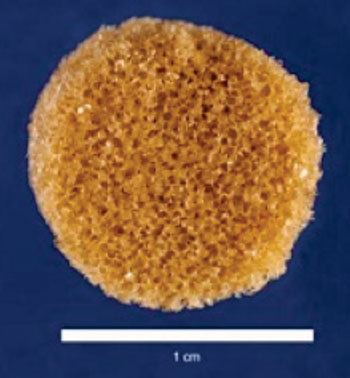Shape Memory Polymer Designed to Help Reconstruct Faces
By LabMedica International staff writers
Posted on 28 Aug 2014
Researchers have developed a “self-fitting” material that expands with warm salt water to effectively fill bone defects, and also acts as a scaffold for new bone growth.Posted on 28 Aug 2014
Birth defects, such as cleft palates, injuries, or surgery to remove a tumor can create gaps in bone that are too large to heal naturally. Furthermore, when they occur in the head, face, or jaw, these bone defects can dramatically alter an individual’s appearance.

Image: A material that changes shape when heated could be used to make custom implants. The white bar is 1-cm-long (Photo courtesy of Melissa Grunlan, Texas A&M).
The researchers described their approach at the 248th National Meeting & Exposition of the American Chemical Society (ACS), the world’s largest scientific society, on August 13, 2014, held in San Francisco (CA, USA). Currently, the most common way to fill bone defects in the face, head, or jaw (the cranio-maxillofacial area) is autografting: a process in which surgeons harvest bone from somewhere else in the body, such as the hip bone, and then try to shape it to fit the bone defect. “The problem is that the autograft is a rigid material that is very difficult to shape into these irregular defects,” said Melissa Grunlan, PhD, leader of the study.
Moreover, harvesting bone for the autograft can itself create complications at the place where the bone was taken. Another strategy is to use bone putty or cement to fill gaps. However, these materials are not ideal. They become very brittle when they harden, and they do not have pores, or small holes, that permit new bone cells to move in and reconstruct the damaged tissue.
To develop a better material, Dr. Grunlan and her colleagues from Texas A&M University (College Station, USA) constructed a shape-memory polymer (SMP) that molds itself precisely to the shape of the bone defect without being brittle. It also supports the growth of new bone tissue.
SMPs are materials whose geometry changes in response to heat. The investigators made a porous SMP foam by linking together molecules of poly(ε-caprolactone), an elastic, biodegradable substance that is already used in some medical implants. The resulting material resembled a stiff sponge, with many interconnected pores to allow bone cells to migrate in and grow. Upon heating to 60 °C, the SMP becomes very soft and pliable. Therefore, during surgery to repair a bone defect, a surgeon could warm the SMP to that temperature and fill in the defect with the softened substance. Then, as the SMP is cooled to body temperature, it would resume its former stiff texture and “lock” into place.
The researchers also coated the SMPs with polydopamine, a sticky substance that helps lock the polymer into position by inducing formation of a mineral that is found in bone. It may also help osteoblasts, the cells that generate bone, to stick and spread throughout the polymer. The SMP is biodegradable, so that eventually the scaffold will disappear, leaving only new bone tissue behind.
To evaluate whether the SMP scaffold could support bone cell growth, the researchers seeded the polymer with human osteoblasts. After three days, the polydopamine-coated SMPs had grown about five times more osteoblasts than those without a coating. Furthermore, the osteoblasts produced more of the two proteins, runX2 and osteopontin, which are critical for new bone formation.
Dr. Grunlan reported that the next phase of the research will be to evaluate the SMP’s ability to heal cranio-maxillofacial bone defects in animals. “The work we’ve done in vitro is very encouraging,” she says. “Now we’d like to move this into preclinical, and hopefully, clinical studies.”
Related Links:
Texas A&M University













